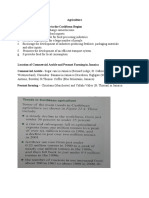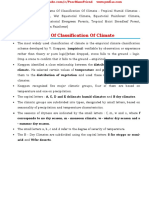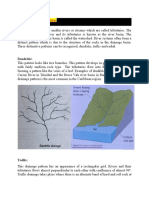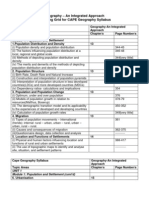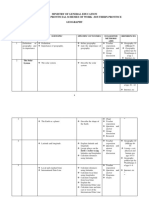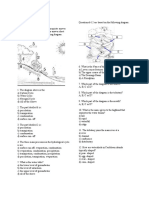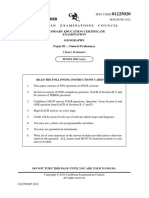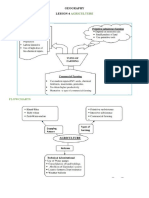Geography Agriculture Notes
Geography Agriculture Notes
Uploaded by
sdbkjbkCopyright:
Available Formats
Geography Agriculture Notes
Geography Agriculture Notes
Uploaded by
sdbkjbkCopyright
Available Formats
Share this document
Did you find this document useful?
Is this content inappropriate?
Copyright:
Available Formats
Geography Agriculture Notes
Geography Agriculture Notes
Uploaded by
sdbkjbkCopyright:
Available Formats
AGRICULTURE GEOGRAPHY CHAPTER-4 ANSWER THE FOLLOWING QUESTIONS Q1. A1.
. WHAT IS THE IMPORTANCE OF AGRICULTURE IN THE INDIAN ECONOMY? The importance of agriculture in the Indian economy is 1. India is an agriculturally important country. 2. Two-thirds of its population is engaged in agricultural activities. 3. Agriculture is a primary activity, which produces most of the food that we consume. 4. Besides food grains, it also produces raw material for various industries. Mention the three characteristics on which the Indian agriculture had been practiced? Main three characteristics of Indian agriculture is 1. Physical environment 2. Technological know-how 3. Socio-cultural practices. 4. Farming varies from subsistence to commercial type. What are the five types of farming? 1 .Primitive subsistence farming 2. Slash and burn farming 3. Intensive subsistence farming 4. Commercial farming 5. Plantation agriculture Write a short note on Primitive subsistence farming. 1. This type of farming is still practiced in few interior parts of India. 2.It is practiced on small patches of land with the help of primitive tools like hoe, Dao and digging sticks, & family community labour. 3.This type of farming depends upon monsoon, natural fertility of the soil and suitability of other environmental conditions to the crops grown. Write a short note on Slash and burn agriculture. The following are the characteristic features of slash and burn agriculture 1.It isslash and burn agriculture. 2. Farmers clear a patch of land and produce cereals and other food crops to sustain their family. 3.When the soil fertility decreases, the farmers shift and clear a fresh patch of land for cultivation. 4. This type of shifting allows Nature to replenish the fertility of soil through natural processes. 5.Productive is low as farmer uses natural fertilizers & simple tools What are the local names of the shifting cultivation? 1. It is jhumming in north-eastern states like Assam, Meghalaya, Mizoram and Nagaland; 2. Pamlou in Manipur, 3. Dipa in Bastar district of Chattishgarh, and in Andaman and Nicobar 4. Bewar or Dahiya in Madhya Pradesh, 5. Podu or Penda in Andhra Pradesh 6. Pama Dabi or Koman or Bringa in Orissa,
Q2. A2.
Q3. A3.
Q4. A4.
Q5. A5. .
Q6. A6.
7. Kumari in Western Ghats, Valre or Waltre in South-eastern Rajasthan, 8. Khil in the Himalayan belt, 9. Kuruwa in Jharkhand, The slash and burn agriculture is known by other name in different parts of the world such as 1. Milpa in Mexico and Central America, 2. Conuco in Venzuela, Roca in Brazil, 3. Masole in Central Africa, 4. Ladang in Indonesia, 5. Ray in Vietnam. Q7. A7. Write a short note on Intensive subsistence farming? 1. This type of farming is practiced in areas of high population pressure on land. 2. It is labour intensive farming, where high doses of biochemical inputs and irrigation are used for obtaining higher production. Why there is an enormous pressure on the agricultural land? 1. The right of inheritance leading to the division of land among successive generations has rendered land-holding size uneconomical, 2. The farmers continue to take maximum output from the limited land in the absence of alternative source of livelihood. 3. Thus, there is enormous pressure on agricultural land. What are the main characteristics of commercial farming? The main characteristic of this type of farming is the use of higher doses of modern inputs, Can you give some more examples of crops which may be commercial in one region and may provide subsistence in another region? The degree of commercialization of agriculture varies from one region to another. For example, rice is a commercial crop in Haryana and Punjab, but in Orissa, it is a subsistence crop. Sugarcane is the commercial crop in Tamil Nadu but rice is the staple crop. Write a note on the plantation farming. 1. Plantation is also a type of commercial farming. In this type of farming, a single crop is grown on a large area.(MONOCULTURE) 2. The plantation has an interface of agriculture and industry. 3. Plantations cover large tracts of land, using capital intensive inputs, with the help of migrant laborers. All the produce is used as raw material in respective industries. 4. Example: In India, tea, coffee, rubber, sugarcane, banana, etc. are important plantation crops. Other examples are Tea in Assam and North Bengal coffee in Karnataka. 5. Production is for the market so a well developed network of transport & communication connecting plantation areas, processing industries & markets plays an important role in development of plantation. Explain the three crop pattern season. The three crop pattern seasons are Kharif, Rabi and zaid.
Q8. A8.
Q9. A9. Q10. A10.
Q11. A11.
Q12. A12.
A) KHARIF i) ii) iii) Kharif crops are sown with the onset of Monsoon in different parts of India and these are harvested in September-October. Important crops grown during this season are Paddy, maize, jowar, bajra, tur (arhar), moong, urad, cotton, jute, groundnut and soya bean. Some of the most important rice-growing regions are Assam, West Bengal, coastal regions Of Orissa, Andhra Pradesh, Tamil Nadu, Kerala and Maharashtra, particularly the (Konkan Coast) along with Uttar Pradesh and Bihar. Recently, paddy has also become an important commercial crop of Punjab and Haryana. In states like Assam, West Bengal and Orissa, three crops of paddy are grown in a year. These are Aus, Aman & Boro B) RABI i) Rabi crops are sown in winter from October to December and harvested in summer from April to June. ii) Some of the important rabi crops are wheat, barley, peas, gram and mustard. iii) Though, these crops are grown in large parts of India, states from the north and northwestern parts such as Punjab, Haryana, Himachal Pradesh, Jammu and Kashmir, Uttaranchal and Uttar Pradesh are important for the production of wheat and other Rabi crops. iv) Availability of precipitation during winter months due to the western temperate cyclones helps in the success of these crops. v) However, the success of the green revolution in Punjab, Haryana, western Uttar Pradesh and parts of Rajasthan has also been an important factor in the growth of the Rabi crop. C) i) ii) iii) ZAID
iv) v)
In between the Rabi and the Kharif seasons, there is a short season during the summer months known as the Zaid season. Some of the crops produced during Zaid are watermelon, muskmelon, cucumber, vegetables and fodder crops. Sugarcane takes almost a year to grow.
Q13. Explain how the growing population is a serious threat to the Indian agriculture? A13. As agriculture is practiced in India for centuries this has resulted in: a) Sustained uses of land without compatible techno-institutional changes that has hindered the pace of agriculture development. b) Even though new sources of irrigational are available still many farmers depend on monsoon, natural fertility for agriculture. c) Thus for the growing population it is a very serious threat.
Q14. A14.
What were the initiatives taken by the government of India in the 1 st five year plan towards agriculture? Why it was not properly implemented? 1. Collectivization 2. Consolidation of holdings 3. Cooperation and 4. Abolition of zamindari These were the provisions of Land reform as per first 5 year plan but right to inheritance has fragmented the land holdings needed for consolidation So, the law on land reform was not implemented properly. Mention the two reforms initiated by the government of India in the year 1960s & 1970s? 1. in 1960 & 70 Green revolution was introduced based on package technology 2. White revolution (operation flood), but it had its impact only in few areas. Mention the comprehensive institutional and technological reform introduced by the government in the year 1980s? In 1980, 90, a comprehensive institutional and technological reform introduced: 1 .Provision for crop insurance against drought, flood, cyclone, fire and disease, 2. Establishment of grameen bank, for providing loan facilities at low interest. Kissan credit card (KCC), personal Accidental Insurance scheme (PAIS), 3. Special weather bulletins and agricultural programmes for farmers were introduced on radio and television. 4. Government announced minimum support price, remunerative and procurement price to check the exploitation of farmers by speculators and middlemen Why Vinobha Baves movement is called as Blood less Revolution? 1. It was a movement where the landless peasants received the agricultural land from the land owners without any revolt or rebellion. 2. Many of the land owners and zamindars donated lands and villages to the landless peasants 3. As per Gandhijis concept of gram swarajya, Vinobha Bhave was able to reach the villagers. What does the GDP of agriculture shows? Why it is serious concern? 1. Agriculture is the backbone of Indian economy but its share in the GDP show a declining trend from 1951 and its share in providing employment and livelihood is high (63%) in 2001. 2. The decline in the share of agriculture in GDP is serious concern Because: any decline and stagnation in agriculture will lead to decline in other spheres of economic development. What are the efforts made by the Indian government to improve upon the agricultural development? Concrete efforts are made by government of India to
Q15. A15. Q16. A16.
Q17. A17.
Q18. A18.
Q19. A19.
Q20. A20.
1. modernize agriculture 2. Establishment of Indian Council of Agricultural Research (ICAR), 3. agricultural universities, 4. veterinary services and animal breeding centre's, 5. horticulture, 6. research and development in the field of meteorology and weather forecast were given priority for improving Indian agriculture, 7. improving rural infrastructure Describe the international challenges faced by the Indian farmers due to globalization? 1. At present, Indian farmers are facing a big challenge from international competition 2. Indian government is going ahead with reduction in the public investment in agriculture sector particularly in irrigation, power, rural roads, market and mechanization. 3. Subsidy on fertilizers is decreased leading to increase in the cost of production. 4. Moreover, reduction in import duties on agricultural products has proved detrimental to agriculture in the country. 5. Farmers are withdrawing their investment from agriculture causing a downfall in the employment in agriculture
You might also like
- The FourDocument1 pageThe FourStephenNo ratings yet
- Geography Case StudiesDocument15 pagesGeography Case StudiesIsrael100% (1)
- Georgraphy High School Syllabus: Republic of ZambiaDocument18 pagesGeorgraphy High School Syllabus: Republic of ZambiaDavid RayNo ratings yet
- Airtel NewDocument64 pagesAirtel NewAbith Gowda100% (2)
- BETTOR TITO DELUXE S2000 INSTALLATION v10Document9 pagesBETTOR TITO DELUXE S2000 INSTALLATION v10ROGER EBYNo ratings yet
- BC Tree BookDocument196 pagesBC Tree BookKevin Brown100% (1)
- Agriculture in The CaribbeanDocument8 pagesAgriculture in The CaribbeanDance-Off 15100% (1)
- CSEC Geography June 2013 P2Document14 pagesCSEC Geography June 2013 P2william lewis100% (1)
- Social Studies NotesDocument554 pagesSocial Studies NotesDaniellePeddie100% (1)
- Urbanization: Causes, Problems and SolutionsDocument15 pagesUrbanization: Causes, Problems and SolutionsAriel TaylorNo ratings yet
- UNIT 2 Geography Self-Study and Distance LearningDocument153 pagesUNIT 2 Geography Self-Study and Distance LearningMikaelia NesbethNo ratings yet
- Bauxite in GuyanaDocument3 pagesBauxite in GuyanaJacqueline100% (1)
- Geography Form 2 AssessmentDocument2 pagesGeography Form 2 AssessmentAriel Lakatoo Ming100% (1)
- GEOGRAPHY NOTES For SURVIVAL PDFDocument22 pagesGEOGRAPHY NOTES For SURVIVAL PDFmathews ismail100% (1)
- Ox-Bow Lake Handout 1Document1 pageOx-Bow Lake Handout 1api-336814146No ratings yet
- Geography Notes - 3 Map ReadingDocument13 pagesGeography Notes - 3 Map ReadingShaquan Fullerton100% (1)
- Climatic Regions.1.EquatorialDocument16 pagesClimatic Regions.1.EquatorialVikram Das100% (1)
- Geofile Contrasting Contemporary Case StudiesDocument4 pagesGeofile Contrasting Contemporary Case StudiesreservoirgeogsNo ratings yet
- Geography SBADocument12 pagesGeography SBADominic Lopez100% (1)
- Grade 9 END OF TERM Social Studies Exam FINALDocument10 pagesGrade 9 END OF TERM Social Studies Exam FINALConrad SawyersNo ratings yet
- CSEC Geography PDFDocument38 pagesCSEC Geography PDFKENNIA DEXTER100% (1)
- Drainage PatternsDocument3 pagesDrainage Patternsapi-298948027100% (1)
- GEOGRAPHY f1 PDFDocument108 pagesGEOGRAPHY f1 PDFSijaona RobertNo ratings yet
- GeographyDocument12 pagesGeographyabhishek singhNo ratings yet
- Coral Reef - Case StudyDocument15 pagesCoral Reef - Case StudyRajeevNo ratings yet
- GeographyDocument28 pagesGeographyarunNo ratings yet
- Cape Geography GlossaryDocument5 pagesCape Geography GlossaryTim Lee50% (2)
- Scales, Gradient and Cross Sections 12-03-2021Document6 pagesScales, Gradient and Cross Sections 12-03-2021Eon Babulal100% (1)
- 11 Geography Notes 22 Soils PDFDocument4 pages11 Geography Notes 22 Soils PDFsusmita sadhukhanNo ratings yet
- New Trendsin History Book 3Document33 pagesNew Trendsin History Book 3bravotango985No ratings yet
- 2023 Jce Geography Marking KeyDocument5 pages2023 Jce Geography Marking Keymtende mwaleNo ratings yet
- Chapter - 16 Coast and Coral ReefsDocument50 pagesChapter - 16 Coast and Coral ReefsgopeNo ratings yet
- Agriculture Geography 160112142549Document46 pagesAgriculture Geography 160112142549Surya100% (2)
- Cape Geography SyllabusDocument9 pagesCape Geography SyllabusKern Grant100% (2)
- Full Notes All SubjectsDocument2 pagesFull Notes All Subjectswanga, issah omaryNo ratings yet
- The Restless EarthDocument164 pagesThe Restless Earthb_osborneNo ratings yet
- Geography Lesson NotesDocument3 pagesGeography Lesson Notesteju.ganeshcNo ratings yet
- F2 History Notes 2024Document56 pagesF2 History Notes 2024edwinmasaiNo ratings yet
- Geo SkillsDocument9 pagesGeo SkillsMel Buckley0% (1)
- Geography 10-12 SchemesDocument31 pagesGeography 10-12 SchemesFungai MuyambangoNo ratings yet
- Social Studies Notes and RevisionDocument599 pagesSocial Studies Notes and Revisionnaseeb100% (1)
- Myanmar's GeographyDocument12 pagesMyanmar's GeographySu Myat NoeNo ratings yet
- Geography Paper 1 MockDocument17 pagesGeography Paper 1 MockOwen KaputulaNo ratings yet
- Form 1 Geography NotesDocument16 pagesForm 1 Geography Notesbirgenenock47No ratings yet
- Cape Geography IADocument18 pagesCape Geography IAAbigail Clarke100% (1)
- CSEC Question - UrbanisationDocument1 pageCSEC Question - UrbanisationShanta Mathai100% (2)
- Map Reading NotesDocument6 pagesMap Reading NotesChikuta Shingalili100% (1)
- Geography Project: Name-Class - Sec - Roll No. - SessionDocument8 pagesGeography Project: Name-Class - Sec - Roll No. - SessionMarroon Gaming50% (2)
- Form 1 GeographyDocument56 pagesForm 1 Geographyhussain korirNo ratings yet
- Geography NotesDocument185 pagesGeography NotesShubham SinhaNo ratings yet
- Geography Rivers and Limestone Multiple ChoiceDocument4 pagesGeography Rivers and Limestone Multiple ChoiceAriel Lakatoo Ming100% (2)
- Role and Importance of Agriculture in The CaribbeanDocument13 pagesRole and Importance of Agriculture in The CaribbeanJagdeesh Gosine33% (3)
- Agricultural Geography 3.1Document74 pagesAgricultural Geography 3.1ogingahenryb10No ratings yet
- CAPE Geography Specimen 2016 U2 P1Document14 pagesCAPE Geography Specimen 2016 U2 P1Raymond Lutchman100% (3)
- CSEC Geography June 2012 P2Document16 pagesCSEC Geography June 2012 P2aubrey wallis100% (1)
- Geography CAPE Unit 1 TextbookDocument12 pagesGeography CAPE Unit 1 TextbookAmelia TaylorNo ratings yet
- Mapwork CalculationsDocument14 pagesMapwork CalculationsmalvindutiroNo ratings yet
- Geography Cape Exam Notes: Done by Amelia TaylorDocument14 pagesGeography Cape Exam Notes: Done by Amelia TaylorAmelia TaylorNo ratings yet
- CSEC Geography June 2005 P032Document8 pagesCSEC Geography June 2005 P032william lewisNo ratings yet
- 1 Intro To Worldpopulation DensityDocument53 pages1 Intro To Worldpopulation Densityapi-29631793867% (3)
- Urban Rural Equity IssueDocument3 pagesUrban Rural Equity IssueShekinah Puntilar100% (1)
- What Is GeographyDocument7 pagesWhat Is GeographyAshleigh Wray100% (1)
- FkdvnkdkefvnDocument20 pagesFkdvnkdkefvnkmgnrkjbsNo ratings yet
- JH - EcampusUpload - SubjectNote - STD10-GEOG - AGRICULTURE IN INDIA 2Document20 pagesJH - EcampusUpload - SubjectNote - STD10-GEOG - AGRICULTURE IN INDIA 2Zian HansotiaNo ratings yet
- Peter Swirski - From Literature To Biterature - Lem, Turing, Darwin, and Explorations in Computer Literature, Philosophy of Mind, and Cultural Evolution-Mcgill Queens University Press (2013)Document244 pagesPeter Swirski - From Literature To Biterature - Lem, Turing, Darwin, and Explorations in Computer Literature, Philosophy of Mind, and Cultural Evolution-Mcgill Queens University Press (2013)Alejandro Del VecchioNo ratings yet
- An Introduction To Purchasing StrategyDocument1 pageAn Introduction To Purchasing StrategynezorbeNo ratings yet
- Depresión 5Document24 pagesDepresión 5Luz Maria RojasNo ratings yet
- En 1993 07Document168 pagesEn 1993 07Vio ChiNo ratings yet
- Sheikha Lubna Al QasimiDocument1 pageSheikha Lubna Al QasimiChaitali Banerjee RoyNo ratings yet
- SDSC MujtabaBaqarDocument11 pagesSDSC MujtabaBaqarTanveerNo ratings yet
- Book 45 The Art of Meditation###Document146 pagesBook 45 The Art of Meditation###shuklaarav100% (2)
- Vacancy Circular For Deputation of UDCDocument14 pagesVacancy Circular For Deputation of UDCAMOL V SULENo ratings yet
- 09 Sperre Pleat Coolers Technical DocumentationDocument18 pages09 Sperre Pleat Coolers Technical DocumentationJohanNo ratings yet
- Superimposed Dead Loads and Live Loads Load MagnitudeDocument8 pagesSuperimposed Dead Loads and Live Loads Load MagnitudeLouieNo ratings yet
- Quiz 17 - ParcorpDocument4 pagesQuiz 17 - Parcorprhelyn dato-onNo ratings yet
- Sources of Misunderstanding in Intercultural CommunicationDocument21 pagesSources of Misunderstanding in Intercultural CommunicationMark Kian Gatchalian0% (1)
- Baldo (2015) The Effect of Different Genres of Music On The Growth of Radish Plant (Raphanus Sativus)Document66 pagesBaldo (2015) The Effect of Different Genres of Music On The Growth of Radish Plant (Raphanus Sativus)StiltonNo ratings yet
- PRE-6 Lecture On Audit Cycle - Revenue, Collection, Acquisition, Payment, Payroll and PPEDocument36 pagesPRE-6 Lecture On Audit Cycle - Revenue, Collection, Acquisition, Payment, Payroll and PPEPaupauNo ratings yet
- Sonnet 18 WorksheetDocument11 pagesSonnet 18 Worksheetعلي هاشم وزيريNo ratings yet
- The Fourfold Visions of William Blake and Martin HeideggerDocument10 pagesThe Fourfold Visions of William Blake and Martin HeideggerOliver Medina Oliver MedinaNo ratings yet
- Pretesis Es 98bibliografia PDFDocument6 pagesPretesis Es 98bibliografia PDFAndres Felipe CameroNo ratings yet
- Vasudevan 2019Document2 pagesVasudevan 2019Vassu DevanNo ratings yet
- Garua - Partitura PDFDocument6 pagesGarua - Partitura PDFJavier Salnisky MusicoNo ratings yet
- Business PlanDocument22 pagesBusiness PlanRachelle Anne Mojica PalecpecNo ratings yet
- EZLibrary by Paul & ShubhamDocument33 pagesEZLibrary by Paul & ShubhamGUNAKHSA MHATRENo ratings yet
- Communication in PoliceDocument4 pagesCommunication in PolicekkNo ratings yet
- SBFP Form 4-6Document38 pagesSBFP Form 4-6Teresita TarrayoNo ratings yet
- Module 6Document21 pagesModule 6Leonora CidNo ratings yet
- Facebook Ads Optimization GuideDocument20 pagesFacebook Ads Optimization GuideAllfacebook.de - Facebook Marketing Blog100% (2)
- Sampling Strategy and Sample Size For A Qualitative Research PlanDocument5 pagesSampling Strategy and Sample Size For A Qualitative Research PlanbakedcentipedeNo ratings yet






